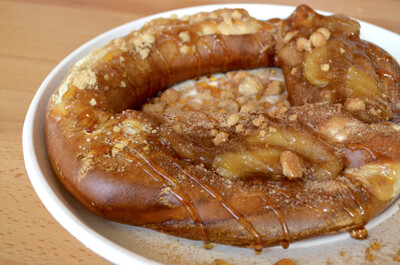

Legend has it, the shape of her arms inspired Frider to shape the German pretzel as we know it now – a loaf through which the sun can shine three times. She was losing her patience, too, and watched him standing in the door frame, her arms crossed. In the end it was his wife who unintentionally gave him the winning hint. The earl told him: “Dear friend, bake a loaf through which the sun can shine three times.” If he completed the task within three days, the earl would give him back his old life.įrider was more than happy, but lacked good ideas under the huge pressure he had to face. But before the sentence was executed, Frider was offered one last chance. The earl threw Frider in the dungeon and sentenced him to death.

The earl, Graf Eberhard V., was sick of the bad bakin skills of its baker Frider. At that time, in a small German city called Bad Urach, the yard baker of the ruling earl invented it from deathly necessity. The probably most famous story goes back to the 15th century. How the Invention of the Pretzel Saved a Baker’s Life So it is only fair, to tell one story each ‘pretzel home’ of the invention of this popular pastry. As already mentioned, pretzels are most popular in the two southern regions of Germany, Swabia and Bavaria. Of course, there are also myths and legends about the grandma of all German pastries. The shape probably devolved from the Roman ring shape to a double-six and developed later to the typical pretzel shape. The oldest image of a Pretzel was found on a painting of the Last Supper from the 11th century. The pretzel, or at least its shape, is probably even older than 1,000 years. So where does this fascination and seemingly never-ending love for pretzels in Germany come from? The Famous Pretzel Shape You can get Pretzels in every German bakery and in some cities, especially in Bavaria, you will even find pretzel stands around public spaces like markets or train stations. Germany simply are accustomed to it from as early as you can eat solid food. You could probably say, as a German you don’t really have a choice about whether you like pretzels or not. Particularly for younger children, as they are easy to hold and eat without making a mess. The typical Swabian pretzel, varying in the thickness of its strings, distinguishes from the Bavarian one, which traditionally is thicker.Įspecially in these regions, pretzels are a very common snack.

It is especially popular in the southern parts of Germany, in particular Bavaria and Swabia.
Bavarian pretzel skin#
The typical German pretzel though is salty and complemented by lye treatment, which gives the pastry its famous tanned skin and flavor. There are sweet and salty pretzels, depending on what kind of dough they use. Read on to find out more about the history of the German pretzel! To Get Things Started – Some Facts About The German PretzelĪ Pretzel, ‘breze’ or ‘brezel’ in German, is a type of baked pastry in the shape of a knot. And it has been for many years, even centuries. Besides many exaggerated stereotypes probably every country faces, the pretzel really is one of the most popular pastries among Germans. Besides beer and sausages, the shape of the German pretzel is probably one of the key figures linked to the perception of German culture.


 0 kommentar(er)
0 kommentar(er)
